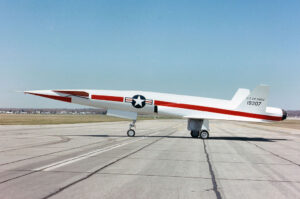On August 27, 1956, the eighth of 13 North American X-10s, GM-52-1, c/n 8, was on flight number 24, out of Cape Canaveral, Florida for a full-range test with a final dive maneuver.
“This was the final flight of the eighth X-10, which had previously undergone three successful recovered missions.
During takeoff, the vehicle went aloft then settled back to the runway with its brakes locked. The tires burst, the gear failed, the gear doors came in contact with the runway, carving grooves in the pavement as they retracted.
Then, astonishingly, the vehicle rose from the runway and completed a successful full-range supersonic flight with terminal dive into the waters off Grand Bahamas…
 To facilitate the development of a “long-range Navaho surface-to-surface cruise missile, North American Aviation (NAA) developed the RTV-A-5 (Research Test Vehicle, Air Force), or X-10 in 1951. This vehicle was to prove critical flight technology for the design of the Navaho cruise missile. These included proving the basic aerodynamics to Mach 2, flight testing the inertial guidance unit and flight control avionics to the same speed, and validate the recovery system for the next phase in the Navaho program.
To facilitate the development of a “long-range Navaho surface-to-surface cruise missile, North American Aviation (NAA) developed the RTV-A-5 (Research Test Vehicle, Air Force), or X-10 in 1951. This vehicle was to prove critical flight technology for the design of the Navaho cruise missile. These included proving the basic aerodynamics to Mach 2, flight testing the inertial guidance unit and flight control avionics to the same speed, and validate the recovery system for the next phase in the Navaho program.
The preliminary design of the X-10 was completed in February 1951 and the first vehicle was delivered to Edwards Air Force Base in May 1953. The first flight occurred on 14 October 1953.
At the time it entered service, the X-10 was one of the fastest turbojet-powered aircraft flown. From 1953 to 1955 a total of five X-10s flew 15 flights at Edwards AFB.
Of all the X-10s built, only one survived the test program: serial 51-9307, the first X-10 to fly. Of the other four aircraft that flew at Edwards AFB, one exploded on takeoff, one was lost in flight, and the remaining two were destroyed in landing accidents. As for the vehicles flown at Cape Canaveral, three were expended in planned dive-in flights against Grand Bahama Island, and two were lost in landing accidents.
In 1958, the remaining three Cape Canaveral X-10s were selected for use as high-speed targets for the BOMARC surface-to-air missile. The plan was to recover and reuse the X-10, not to have them shot down by the BOMARC. None of these vehicles completed their target flight: two were lost when landing and the third suffered a mechanical problem forcing it to be flown into the Atlantic.” (2)
Source: (1) Wikipedia:Portal/Aviation; (2) Wikipedia
